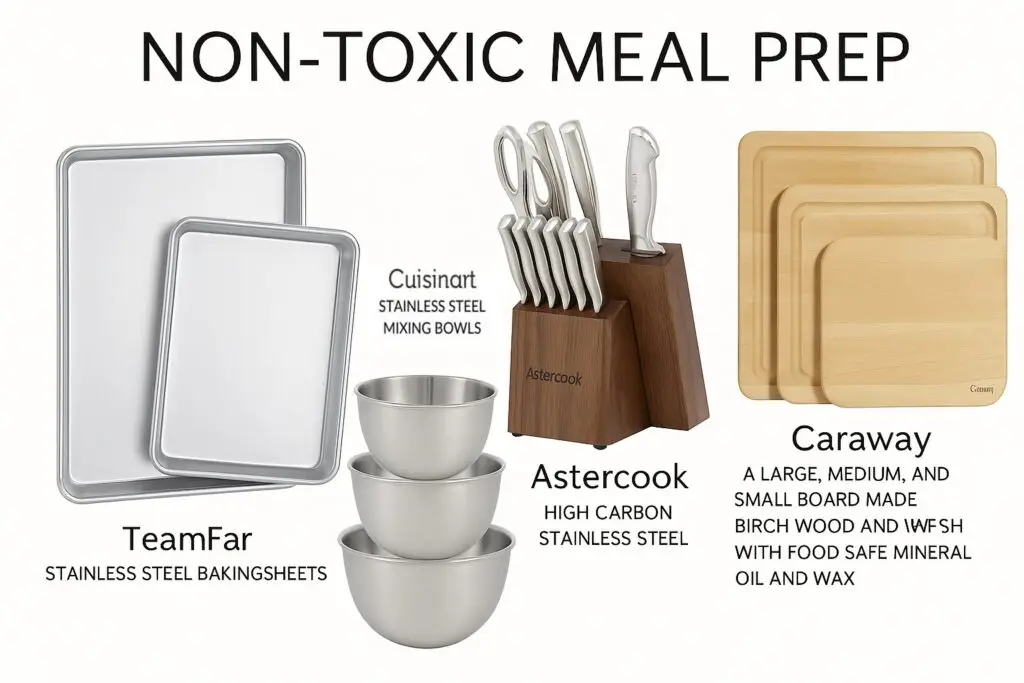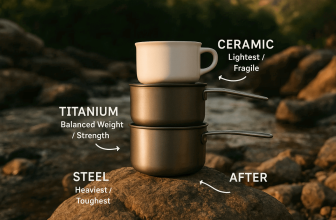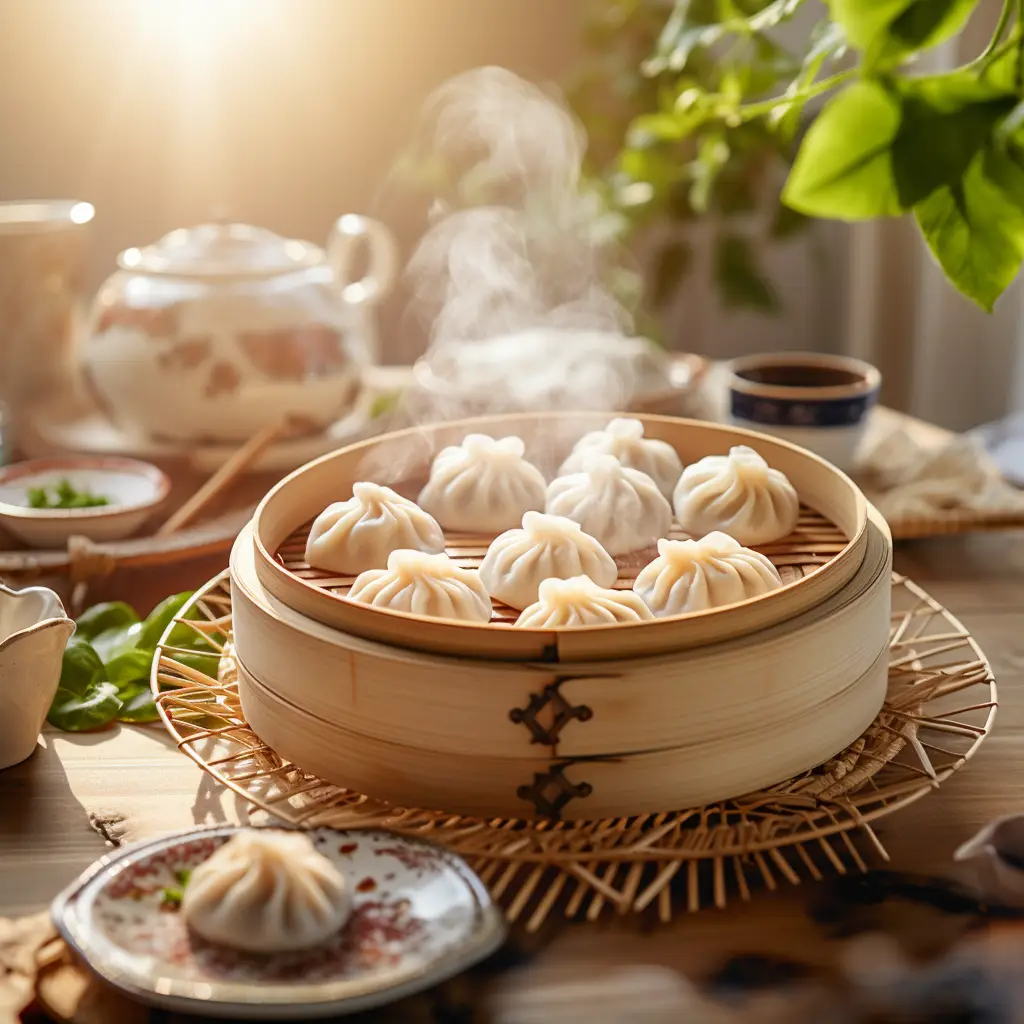9 Non Toxic Kitchen Swaps for Toxic-Free Kitchen in 2025
There are numerous hidden dangers in your kitchen. PFAS (found in Teflon coatings), BPA, and phthalates are examples of “forever chemicals” that can be found in common cookware and tools. Microplastics are even released by everyday objects like sponges and wraps. These toxins can build up in your body over time and cause health issues. One of the simplest methods to lower your exposure is to swap out a few high-risk items for safer ones. This list identifies toxic kitchen items that you should stay away from and provides easy non-toxic kitchen swaps for each.
Why Kitchen Toxins Matter
A lot of artificial chemicals wind up in the kitchen and have the potential to contaminate our food. Food, water, and dust have been found to contain microplastics, which are microscopic pieces of plastic from broken tools or packaging. They can cause inflammation and contain other harmful substances. BPA, which is found in hard plastics and epoxy linings, and phthalates, which are used to soften plastics, are recognized endocrine disruptors that mimic hormones. For instance, exposure to BPA has been connected to developmental and brain issues in children. Thyroid disorders, cancer, and immune system dysfunction are all linked to PFAS, or “per- and polyfluoroalkyl substances,” like those found in nonstick cookware. In summary, these substances can accumulate in the human body and persist in the environment, which may pose a number of health risks. The first step in removing these chemicals from your kitchen is understanding how they get there, including through plastic containers, coatings, and even dishware.
9 Toxic Kitchen Items You Should Replace Immediately
1. Non-stick pans with Teflon (PFAS coatings) : Most non-stick cookware uses PTFE (Teflon), a polymer form of PFAS, is used in the majority of non-stick cookware. When these “forever chemicals” get too hot (above roughly 500°F), they can release harmful fumes. Birds are especially sensitive to the flu-like condition known as “polymer fume fever,” which has been linked to occupational exposure to overheated Teflon. Although experts advise using these pans at moderate heat and discarding any coatings that are clearly deteriorated, they are generally regarded as low-risk. Change to cookware made of stainless steel, ceramic, or cast iron for a non-toxic swap.
2. Plastic storage containers: A lot of microwaveable containers and bins are composed of materials that contain bisphenol A or BPA, and phthalates are frequently found in soft plastics. These substances have the ability to seep into food when heated or scratched. BPA can leak from containers and have an impact on children’s developing hormones and brains. BPA and phthalates are known to disrupt hormones. Swap out toxic products: For storing and reheating food, use glass or stainless steel containers. These materials last almost indefinitely and do not leach plastics.
3. Common plastic or nylon cooking utensils, such as ladles, spoons, and spatulas, may contain unidentified additives. Concerns regarding phthalates, PFAS, and microplastics from plastics that come into contact with food have grown as a result of research. Tiny fragments or chemicals may migrate into food as a result of prolonged heat exposure, including dishwasher cycles. Swap out toxic products: Make the switch to silicone utensils that are certified food-grade or bamboo. Utensils made of bamboo or stainless steel are heat-stable and do not release plastics. Additionally, silicone spatulas don’t leach when exposed to high heat.

4. Gloves and PVC dish mats: Vinyl (PVC) products frequently include harmful additives. Interestingly, phthalates and other plasticizers can be found in high concentrations in vinyl gloves and mats. Disposable PVC food service gloves, such as those used in restaurants, can occasionally contain phthalates that seep into food, according to a 2019 study. Because of its dangerous additives, vinyl is even known as “the poison plastic.” Swap out PVC for silicone or nitrile gloves and 100% cotton dish towels for a non-toxic alternative. Plasticizers are completely avoided in kitchen textiles made of organic cotton or natural rubber.
5. Cutting boards made of plastic: Although they might appear innocuous, plastic chopping boards eventually shed plastic. According to a recent study, cutting boards made of polyethylene are a “significant source” of microplastics in food, releasing between 7 and 50 grams of plastic per person annually through regular use. This can harbor bacteria in deep cuts in addition to increasing the consumption of microplastic. Switch to bamboo or hardwood cutting boards for a non-toxic swap. Woods do not break down into microplastics and are naturally knife-friendly, which contributes to their hygienic qualities.
6. Aluminum bakeware and foil: Aluminum foil, pots, and pans do add traces of aluminum to food. According to laboratory tests, some aluminum may seep into food when cooked in an acidic or extremely hot environment. The majority of dietary aluminum is expelled, with only a “very small amount” being absorbed. That is to say, healthy adults are unlikely to suffer any negative effects from occasional foil use. Non-Toxic Swap: Use ceramic or stainless steel bakeware and liners if you would rather avoid even this small amount of exposure.
7. Traditional sponges: Plastic polymers make up the standard yellow/green kitchen sponge. Tiny microfiber fragments wash out of dishes and down the drain each time you wash them. These microfibers, which wind up in rivers and seas, are basically microplastics. In addition to being polluting, inexpensive sponges can harbor bacteria and are not biodegradable. Biodegradable scrubbers, such as cellulose (wood pulp) sponges or coconut-fiber scouring pads, are a non-toxic swap. These sponges made of natural fibers are good at cleaning, decompose in compost, and don’t shed plastic.
8. Dish soaps with a strong scent Dish soaps with scents frequently conceal a concoction of harmful substances. The term “fragrance” can conceal dozens of artificial ingredients, such as artificial musks and phthalates. Endocrine disruptors include phthalates, which are used to prolong fragrances. Paraben preservatives, which are frequently found in soaps, also function similarly to hormones. These substances can be absorbed through the skin, even if you rinse soap off dishes. Switch to a plant-based, unscented dish soap (look for products that are EWG-Verified or comparable) for a non-toxic swap.

9. Zipper bags and plastic wrap: Single-use plastic bags and wraps contain plasticizers and polymers that can seep into food. The majority of plastic cling wrap is composed of PVC and DEHA, a plasticizer. Research indicates that DEHA moves from wrap to fatty foods like cheese. Furthermore, plastic wrap that has been heated or microwaved may release chemicals and microplastics into your food. Non-toxic swap: Switch out Ziploc bags and cling film for reusable options like silicone food storage bags, beeswax-coated cloth wraps, or silicone lids.
How to Replace One Item at a Time Without Getting Overburdened
Going chemical-free involves making gradual, small adjustments rather than a major cleanup overhaul. As new things are inevitably needed, start by replacing the old ones. For instance, replace your outdated spatula or pan with a non-toxic one when it wears out. Experts advise replacing broken plastic items rather than throwing them all away at once. Swap out plastic storage first, then dishware, then cleaning supplies, etc., if you prefer to focus on one category per month. Follow a straightforward plan or print our checklist and proceed step-by-step. A much safer kitchen will result from these deliberate swaps over time.
Tips for a Non-Toxic Kitchen
Here’s what I found to be effective if you’re interested but unsure where to start:
1. Change One Item at a Time
I started by swapping out my baking sheets. My mixing bowls come next. My kitchen gradually became less stressful and safer.
2. Continue Using Safer Materials
Choose glass, ceramic, wood, or stainless steel. Avoid Teflon, plastic, and coated cookware.
3. Buy Products You’ll Actually Use
My top swaps that had a significant impact are as follows:
🧁 TeamFar Baking Sheet & Rack Set in Stainless Steel
My old crumbling bakeware was replaced by this non-toxic, food-grade stainless steel pan and rack, which bakes everything uniformly and without harmful coatings.
🥣 Three KitchenAid Stainless Steel Mixing Bowls
These are dishwasher safe, lightweight, and long-lasting, making them ideal for preparing sourdough or tossing salads without worrying about plastics leaking.
🔪 Block & Sharpener Astercook Knife Set
A reasonably priced, fashionable set of knives with a BPA-free block, high-carbon stainless steel blades, and an integrated sharpener that I really use.
🌿 Non-Toxic & Recycled Caraway Cutting Board Set
These are safe to use for preparing meats, produce, or anything in between because they are color-coded, made sustainably, and don’t contain any dangerous glues or plastics.









